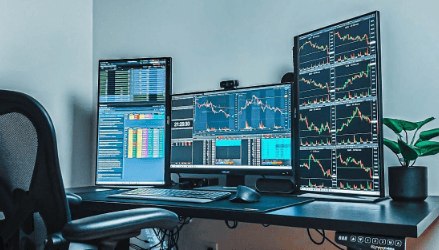From Novice to Pro: Setting Up Your First Trading Computer

When it comes to navigating the fast-paced world of trading, having the right tools at your disposal can make all the difference. A powerful trading computer tailored to your needs can provide you with the edge you need to transition from a novice to a pro trader. In this guide, we’ll walk you through the essential steps to set up your first trading computer. Whether you’re new to trading or looking to upgrade your current setup, this article will help you make informed decisions every step of the way.
Understanding the Basics
Before diving into the technical details, it’s important to understand the fundamentals of what makes a trading computer different from your everyday computer. A trading computer is designed to handle the intense demands of trading platforms, real-time data feeds, and complex analytical tools. It’s your gateway to the markets, and its performance can directly impact your trading success.
Selecting the Right Hardware
- Processing Power Matters – The heart of your trading computer lies in its processor. Opt for a high-performance CPU (Central Processing Unit) that can handle multiple tasks simultaneously. A CPU with strong single-core performance is essential for swiftly executing trades and processing real-time data. Look for processors from reputable brands like Intel or AMD, with multiple cores and high clock speeds.
- Memory (RAM) and Multitasking – To smoothly run your trading software and analysis tools, an ample amount of RAM is crucial. Consider at least 16GB of RAM, as this will allow you to multitask without slowing down your computer’s performance. Remember, when trading, having multiple applications open simultaneously is often a necessity.
- Storage Solutions – Fast storage is essential for quick system boot-ups and loading your trading applications without delay. Consider investing in an SSD (Solid State Drive) for your operating system and frequently used software. This will greatly enhance the overall responsiveness of your trading computer.
Optimizing Your Setup
- Multiple Monitors for Increased Productivity – Many professional traders opt for multiple monitors to enhance their workflow. This setup allows you to monitor various trading charts, news feeds, and other essential information simultaneously. A dual or triple monitor setup can significantly boost your productivity by reducing the need to constantly switch between windows.
- Graphics Card Considerations – While a high-end gaming graphics card might not be necessary for trading, having a decent GPU (Graphics Processing Unit) can still be beneficial. A good GPU can assist with rendering charts and graphics, ensuring a smooth visual experience as you analyze market trends.
Building vs. Buying
- Building Your Own Trading Computer – If you’re tech-savvy and enjoy customizing every aspect of your setup, building your own trading computer can be a rewarding experience. It allows you to select each component according to your preferences and budget. However, keep in mind that building a computer requires technical knowledge and time for assembly and troubleshooting.
- Pre-Built Trading Computers – For those who prefer a hassle-free approach, pre-built trading computers are readily available. These systems are designed and optimized specifically for trading, saving you the time and effort required for assembling individual components. When choosing a pre-built option, ensure it meets the hardware requirements discussed earlier and is backed by good customer reviews.
Software Essentials
- Operating System Considerations – Your choice of operating system (OS) can impact your trading experience. Both Windows and macOS are popular choices, with Windows being the more prevalent option due to its compatibility with a wide range of trading software. Linux can also be considered, but make sure your trading software is compatible with your chosen OS.
- Security Software – Given the sensitive nature of trading, prioritizing cybersecurity is a must. Invest in reputable antivirus and firewall software to protect your trading computer from malware, phishing attacks, and other online threats.
- Trading Platforms and Analysis Tools – Selecting the right trading platform and analysis tools is pivotal to your success. Research different platforms and consider demo accounts to find the one that suits your trading style and preferences. Whether you’re into day trading, swing trading, or long-term investing, the right software can streamline your trading activities.
Fine-Tuning for Performance
- Regular Maintenance – Just like a high-performance car, your trading computer requires regular maintenance to keep running smoothly. Regularly update your operating system, drivers, and trading software to ensure optimal performance. Additionally, keep your workspace clean and free from dust to prevent overheating.
- Minimizing Background Processes – To maximize your computer’s performance during trading hours, close unnecessary background applications and processes. This reduces the strain on your CPU and RAM, allowing your trading software to run efficiently.
Conclusion
Setting up your first trading computer marks a significant step in your journey from a trading novice to a professional trader. By understanding the hardware requirements, optimizing your setup, and choosing the right software, you’re creating a solid foundation for your trading success. Whether you decide to build your own computer or opt for a pre-built solution, remember that your trading computer is a tool that empowers you to navigate the complex world of trading with confidence. Keep learning, stay informed, and continuously fine-tune your setup to adapt to the ever-evolving demands of the market. Your trading computer is not just a machine – it’s your partner in the pursuit of financial growth.